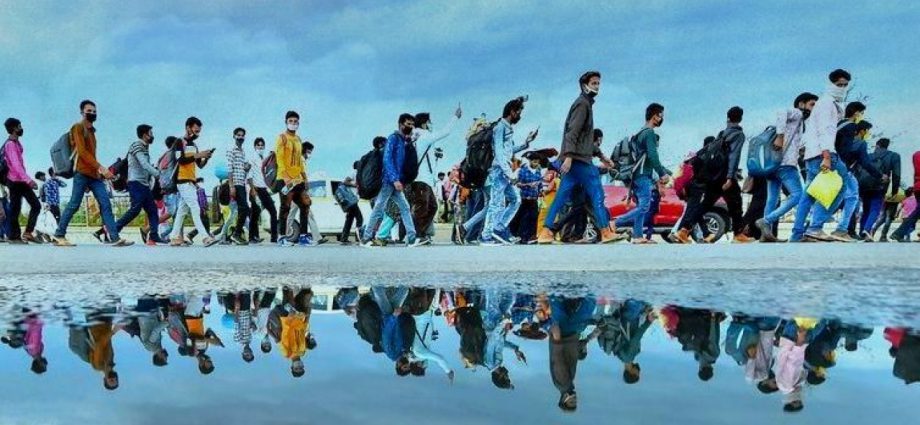

A devastating lockdown against the coronavirus pandemic since late March in India has precipitated a major humanitarian crisis. Many have died as laborers are forced to reverse migrate from cities to villages, yet the government has faced no accountability. Using credible data, The Polis Project’s Violence Lab tries to assess the heavy price that India’s poorest are paying for brutal state policy.
On 12 May 2020, Indian Prime Minister Narendra Modi addressed the nation during a dinner time broadcast. In this speech, stressing on the concept of self-reliance, he commented on the “fragrance of workers’ sweat” in an odd romanticization of the hardship faced by the poorest people in India. In reality, as he spoke those words, millions of India’s poorest were struggling under the debilitating weight of an unprecedented policy where, to beat a pandemic, a nation of over a billion people were effectively shut down with a four-hour notice on 24 March 2020.
The reality of the condition of poor workers, migrant workers, and their families, however, is a far cry from the poetics of the prime ministerial speech. Economic packages are insufficient to provide them with a safety net, their employment has ended and they, who have subsisted on daily wages, face economic uncertainty and certain starvation. This is the group that had no place to nest or shelter at home. According to estimates, 80,000,000 people could no longer afford the burden of staying put in urban areas and hence decided to migrate back to their place of origin in the hope that a network of social support could catch them as they fell.
The current COVID-19 pandemic is peeling off the masks that protect states and institutions. Currently, the strategy of most countries to combat the coronavirus pandemic rests on various degrees of social distancing, shelter at home, and complete or partial lockdowns. In short, the strategy rests on slowing down the spread of the disease by minimizing contact between individuals.
The first coronavirus case was reported in India on 30 January 2020. The state of Kerala, led by the Chief Minister Pinarayi Vijayan from the Communist Party of India (Marxist), was the only one to pay attention from the start while the central government’s initial response was to focus on evacuation of citizens from overseas, isolation and quarantine of suspected overseas cases that landed in India, and the use of thermal detection at some airports. Community transmission was only established by late March and on 24 March 2020, a full lockdown was announced.
This decision, however, became the cause of a humanitarian crisis.
India has one of the largest populations of informal labor and migrant labor anywhere in the world. About 90% of Indian labor is in the informal sector: people often work for less than minimum wage and don’t have secure employment. This is the case, for example, of seasonal workers or laborers employed in the construction business. Many find jobs in urban areas through exploitative labor contractors and are paid daily wages, not weekly or monthly salaries.
Watch this conversation about collecting data and documenting the humanitarian crisis during the lockdown.
With the announcement of the lockdown, these casual migrant workers and their families were the worst affected. They were suddenly unemployed as all economic activity came to a grinding halt and proprietors were unlikely to pay them wages for not working. This was further complicated by the fact that many migrant workers have absolutely no network of social or economic support in urban areas where they work and have hardly any access to medical care. They were suddenly also stranded as public transport shut down and hence they began dangerous and physically exhausting journeys back to their own home towns and villages.
The Indian State has underreported or not recorded statistics that could give anyone a platform to criticize their performance. The Government has not collected or released any information pertaining to people who died not because of the pandemic, but because of the harsh lockdown and its impact. While the State’s relationship with data – and especially with data relating to deaths caused by state policy – has always been ambiguous in India, this time there were groups of scholars who built an independent dataset by collecting this data from local and national news reports. As the accuracy of the data is linked to the accuracy of reporting, this dataset may not capture every single death that has occurred due to the lockdown. It is likely that deaths were under-reported in the news cycle, to begin with. However, this is still the only picture that nears accuracy that anyone has been able to compile.
A group comprising Thejesh GN (Founder of Datameet and Public Interest Technologist), Aman (Assistant Professor of Legal Practice at Jindal Global School of Law), Kanika Sharma (Ph.D. student at Emory University), and Krushna Ranaware (Ph.D. student at Syracuse University), supported by Roadscholarz (an action-oriented, volunteer-based network of scholars) took on the arduous task of compiling this data. Their findings are described in detail below. Violence Lab has used the raw data and categories released by the team with their permission and support.
As of 10 October 2020, the pandemic has killed 1,07,471 people in India while the lockdown has killed 971 people.
Fig. 1 is a choropleth map of India which visually represents numbers of deaths due to lockdown in various Indian states. Uttar Pradesh is where the maximum deaths (186) were recorded, which is 24.7 % of the total. While Uttar Pradesh has a large number of migrant workers that work in other parts of the country, Maharashtra is a recipient of the bulk of migrant labor from states like Uttar Pradesh and Bihar. Maharashtra recorded the next highest number at 81 deaths due to the lockdown, followed by Madhya Pradesh at 61. Telangana recorded 41 deaths while Tamil Nadu had 35 deaths. Kerala recorded 23 deaths, 11 of which were caused by alcohol withdrawal that in some cases led to suicides.

Accidents, starvation, and suicide are the leading causes of death. The maximum accidents were recorded in Uttar Pradesh (79) followed by Maharashtra (27) and Madhya Pradesh (26). There were 215 starvation deaths and 133 suicides accounting for 28.5% and 18.2% of deaths. Most starvation deaths were reported and recorded in Uttar Pradesh (30), Gujarat (26) and Maharashtra (25). Most suicides were also recorded in Uttar Pradesh (28) and Maharashtra (21). The reasons for these suicides differ, but broadly speaking they have been caused due to a combination of financial distress, fear of starvation, and incorrectly thinking that one may be COVID positive. There is also a number of suicides and deaths linked to alcoholism. 5.7% of deaths were caused due to withdrawal in the absence of alcohol distribution.
Roughly 9.6% of deaths were caused because of the lack of medical facilities in an emergency situation where someone was unable to access medical help or was denied medical help. Uttar Pradesh and Madhya Pradesh recorded the maximum deaths due to medical neglect. Fig. 2 offers a percentage breakdown of different causes of deaths under lockdown.
Fig. 2: Reasons for deaths under lockdown, 24 March 2020 – 3 July 2020
The high number of suicides reflects the spread of fear, despair, and helplessness at the community level. Lack of effective relief measures, compounded by lack of mental health and emotional support, are showing its effects on people’s lives through these numbers. Fig. 3 offers a state-wise breakdown of deaths by reasons for deaths.
Fig 3: State-wise lockdown deaths and reasons for deaths, 24 March 2020 – 3 July 2020
Fig. 4 offers a comparison of the rates at which COVID-19 has resulted in deaths versus the rate at which deaths have occurred due to the lockdown. While the acceleration of the disease-related deaths has been swift, deaths due to the lockdown policy have also been on an upward trend albeit much more slowly. The most recent cluster of deaths was reported on board Shramik Trains – special trains designated to take migrant workers safely home after nearly two months of lockdown. Shramik Trains deaths symbolize the gross inadequacies of the government’s relief measures. Deaths on these trains have happened as a result of lack of food and water, long delays, heat and exhaustion. Trains that were supposed to reach destinations in a few hours took instead days, increasing the miseries of the workers and their families, and in many cases, causing deaths.

Fig. 4: Non-Virus (Lockdown) Deaths (Source: Thejesh GN’s Non-Covid Deaths Project)
While the Railway Protection Force in India has pegged the number of deaths onboard Shramik Trains at 80, the current data includes 96 such deaths. 63 of these deaths were recorded in unspecified states.
While India’s lockdown is being “unlocked” in different phases, it remains to be seen to what extent there will be any accountability for the hardship and loss of lives caused because of this policy.
(The raw data used to produce this piece have been acquired with the permission and support of Thejesh GN, Kanika Sharma, Aman, Krushna Ranaware under a Creative Commons license. The data are subject to revision as more cases are added to this existing database. Additional research support was given by Sajneet Mangat.)





